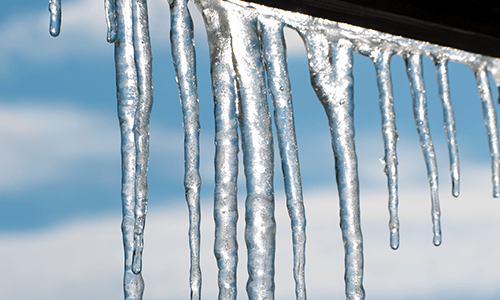If you’ve never seen an ice dam, it actually looks a lot like you would expect. It is an accumulation of ice on along the eave line of a sloped roof. The ice can build and build over the winter months until it is a solid wall that can be feet thick and can span the entire eave line of a roof. The reason ice dams are so detrimental is because, as temperatures rise they can trap the melting snow on the roof behind them creating a little pond of standing water. A sloped asphalt roof is designed to shed water moving in only one direction, down and off of the roof. The second water becomes static and starts to accumulate it can easily defeat even high quality, correctly installed roof components and can cause leaks in the home.
Almost all ice dams start inside the home as a result of heat loss through the attic. The most effective way for properties to deal with ice dam issues is to have a qualified insulation company come in and make a review of the attic spaces. There are three basic things that need to be checked:
- Is there a proper amount of insulation in the attic?
- Are the pipes and ducts sealed where they penetrate into the attic space?
- Is the attic ventilation system functioning properly? Are the soffit vents clear and allowing the intake of cool, dry air?
If the answer to any of these questions is ‘no’ then correcting these issues will go a long way to preventing ice dams this winter. Of course there will be costs in making these improvements, but when compared with how much it costs to get an ice dam removal company out with a steamer, it will be money well spent.
If insulation and ventilation seem adequate, but ice dams persist or if the design of the home makes some or all of the attic incapable of meeting these requirements, then the next step is to consider installing heat cable in the vulnerable areas (usually eavelines, valleys, gutters and downspouts). As long as the heat cable is kept in good working condition and is turned on for the appropriate interval at the correct times, ice dam issues should be minimized if not eliminated completely. There are also professionally installed systems that have sensors that can turn the system off and on for you.
If, for some reason, heat cable is not feasible for your situation, the only other practical preventative measure that can be taken is to diligently remove the snow from the roof as soon as possible after it falls. The snow must be removed before the ice dam forms.
Ice dams and the leaking they cause are not an indication that there is something wrong with the roof. They indicate that the attic is too warm. If this is a persistent problem for any homeowner then a little prevention will go a long ways in controlling in controlling if not eliminating this expensive nuisance.




 Chris Matson
Chris Matson 
 CAI - Illinois Chapter
CAI - Illinois Chapter 


